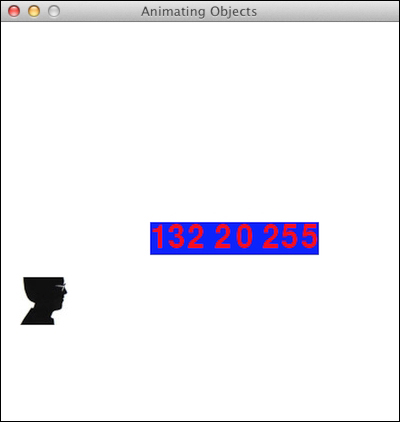Frequently there is a need to display some text, for instance, a counter or a message.
Pygame has a font module that can help us to show text.
Creating a font: We can create a font by specifying, the font filename, and font size as constructor parameters:
font = pygame.font.Font('freesansbold.ttf', 32)Displaying text: Since we made an image move around the edge in the previous recipe, it would be great to display a counter and the position of the image in the center of the screen with a blue background and red letters. The following code snippet accomplishes this:
text = "%d %d %d" % (i, pos[i][0], pos[i][1]) rendered = font.render(text, True, RED, BLUE) screen.blit(rendered, (150, 200))
Note
A screenshot of the animation is shown as follows and should be on YouTube too at https://www.youtube.com/watch?v=xhjfcFhaXN0.

The code is almost the same as for the previous recipe, with the addition of code for the creation and display of fonts:
import pygame, sys from pygame.locals import * import numpy pygame.init() clock = pygame.time.Clock() screen = pygame.display.set_mode((400, 400)) pygame.display.set_caption('Animating Objects') img = pygame.image.load('head.jpg') steps = numpy.linspace(20, 360, 40).astype(int) right = numpy.zeros((2, len(steps))) down = numpy.zeros((2, len(steps))) left = numpy.zeros((2, len(steps))) up = numpy.zeros((2, len(steps))) right[0] = steps right[1] = 20 down[0] = 360 down[1] = steps left[0] = steps[::-1] left[1] = 360 up[0] = 20 up[1] = steps[::-1] pos = numpy.concatenate((right.T, down.T, left.T, up.T)) i = 0 # create a font font = pygame.font.Font('freesansbold.ttf', 32) RED = (255, 0, 0) BLUE = (0, 0, 255) while True: # Erase screen screen.fill((255, 255, 255)) if i >= len(pos): i = 0 screen.blit(img, pos[i]) # displaying text in the center of the screen text = "%d %d %d" % (i, pos[i][0], pos[i][1]) rendered = font.render(text, True, RED, BLUE) screen.blit(rendered, (150, 200)) i += 1 for event in pygame.event.get(): if event.type == QUIT: pygame.quit() sys.exit() pygame.display.update() clock.tick(30)



